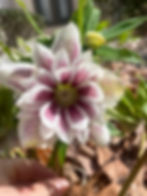Folklore and the Hellebore: The Mythology of the Winter Rose
- Katie Ryzhikov
- Mar 24
- 2 min read
Hellebore, often called the “Winter Rose” or “Christmas Rose,” is a flower shrouded in mystery, legend, and ancient folklore. Blooming in the coldest months when most plants retreat, this striking perennial has long been associated with both healing and poison, purity and darkness. From Greek mythology to medieval superstition, hellebore’s dual nature has made it a plant of fascination for centuries.
A Flower of Myth and Mystery
In Greek mythology, hellebore is tied to the tale of Melampus, a legendary seer and healer. According to legend, the daughters of King Proetus were cursed with madness, believing themselves to be cows and wandering wildly through the land. Melampus used hellebore to cure them, making it one of the earliest known medicinal plants in recorded history. However, this same plant that brought healing also held a darker reputation—its toxic properties were well known, and it was sometimes used in ancient poisonings and rituals.
A Guardian Against Evil
In medieval Europe, hellebore was believed to ward off evil spirits. People planted it near doorways or scattered its dried leaves to protect homes from malevolent forces. Some even believed that the flower could make a person invisible, a superstition that led to its use in certain magical practices. However, the same folklore warned that hellebore must be harvested with care—picking it at the wrong time or in the wrong way was thought to invite misfortune.
The Dual Symbolism of Hellebore
Hellebore’s beauty in winter, when most flowers are dormant, has made it a symbol of resilience and hope. In Christian legend, the plant is associated with the story of a young girl who had no gift to bring the Christ child. As she wept, an angel caused hellebore to bloom in the snow, offering her a gift of natural beauty.
Yet, its poisonous nature reminds us that beauty can have a hidden edge. In Victorian floriography (the language of flowers), hellebore was sometimes associated with scandal, anxiety, or delirium—perhaps a nod to its history in both medicine and mischief.
A Plant of Power and Paradox
Today, hellebore remains a favorite in gardens, prized for its early blooms and striking colors. But its history lingers, a reminder that plants have stories woven into the fabric of human culture. Whether seen as a healer, a protector, or a harbinger of mystery, hellebore continues to captivate those who appreciate the deep roots of folklore in the natural world.

